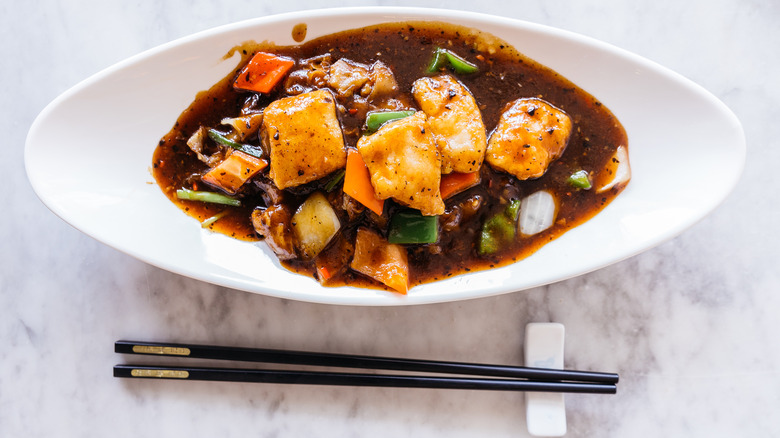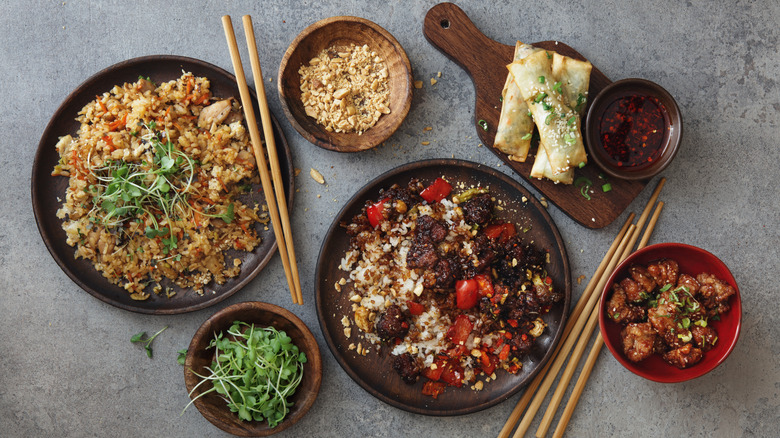The Flavor-Packed Cantonese Sauce Inspired By Luxury Cognac
Sometimes, names can be deceiving. Take everyone's favorite salty and crispy delicacy, for instance; apparently, french fries are so popular in Belgium because they originated there, not France. XO sauce is also a culprit of such deception. To an unknowing person, "XO sauce" sounds like a delicious relish to top off your glass of cognac with — after all, "XO" is a term typically reserved to describe the age of this brandy type.
While "XO" may mean "extra old" in the world of distilled wine, it has no such meaning in this condiment. Additionally, XO sauce contains no trace of cognac at all. Instead, it's a sauce that primarily consists of dried seafood and Chinese cured ham, among other things, and it's described as sweet, smoky, and salty with a dash of umami.
XO sauce originated in Hong Kong during the 1980s. Cognac is viewed as luxurious and expensive, and so, "XO" happens to be slang in Hong Kong for an object that is high-end. Thus, the sauce was named after the drink to reflect its elevated status.
Are the ingredients in XO sauce truly luxurious?
Although XO sauce does not contain any cognac, it is pretty expensive, just like the brandy itself. Its high price is due to the components used to make the sauce. A typical XO sauce features dried scallops, dried shrimp, cured ham, shallots, chili, oil, and other seasonings. But XO sauces may vary among restaurants and brands. Some recipes also opt for fresh shrimps and scallops.
Dried scallops, which can go for up to $50 a pound, are usually to blame for leaving the chunky condiment with a heavy price tag. Food brands such as Lee Kum Kee are selling XO sauces for as much as $26 on Amazon.
XO sauce can also be found at some Asian supermarkets. But if you're ambitious enough to make the stuff at home, it does involve properly cooking scallops, shrimps, and cured ham — alternatively, you could use bacon or prosciutto as a substitute for ham. Once the seafood and meat is cooked, add them to a food processor along with the spices. Blend the mixture until it becomes paste-like, then transfer it to a skillet. Stir until the sauce becomes dark brown.
Top off nearly anything with XO sauce
Once XO sauce was invented, it instantly became a staple in Cantonese cuisine. Eventually, the condiment became a hit outside of Hong Kong, too. If you haven't used XO sauce yet, don't worry; it couldn't be any simpler to add to your diet. The sauce can be used as a finishing garnish or incorporated into your everyday cooking. Naturally, you can splatter XO sauce onto Cantonese dishes, such as ginger-soy steamed fish and wonton noodle soup. Or it can be a dipping sauce for Cantonese-style roasted duck and other meats.
XO sauce is also used to elevate simple dishes. Try adding a spoonful of the sauce to your next plate of stir-fry, fried rice, or fried noodles. Additionally, XO sauce can be used to introduce a meaty flavor to vegetables. Try making an XO sauce-infused vegetable stir-fry with Chinese water spinach and bok choy. Or shiitake mushroom stir-fry flavored with XO sauce. However you use it, just about a tablespoon of the stuff is recommended.


